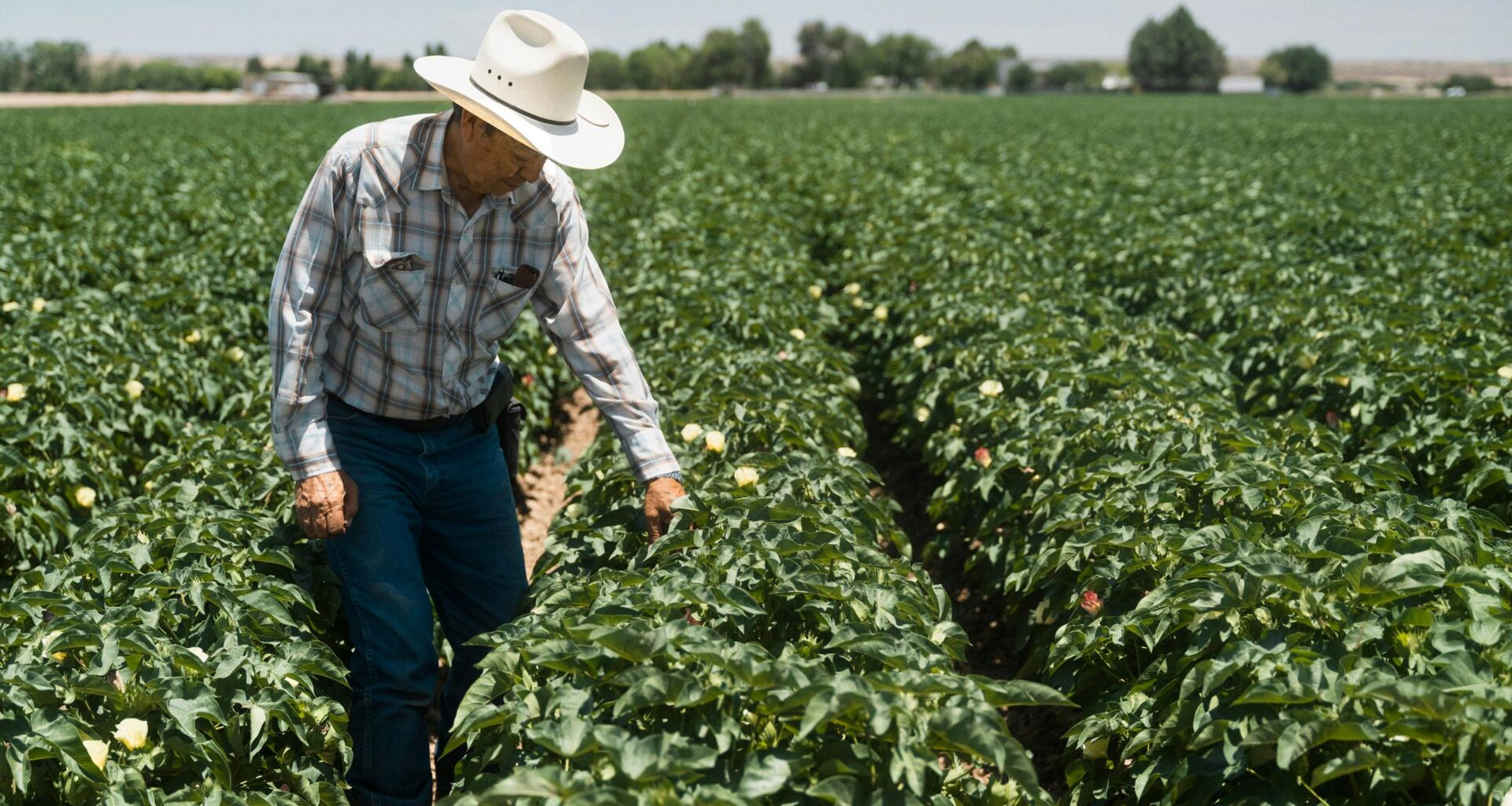As we broiled beneath a relentless sun in the Chihuahuan Desert, next to countless rows of improbably green cotton plants, I expected Ramon Tirres to tell me that water is his most precious resource. In the valley south of El Paso, Tirres grows cotton and pecans, and for the past 23 years, he’s farmed in the midst of historic drought. But as the wiry 71-year-old toed the dirt next to one of the canals that waters his fields, Tirres told me he’s facing a more pressing shortage: “The big issue we’re having now is finding workers,” Tirres said. “God almighty, is it hard.”
Three years ago, Tirres began working to get an H-2A employment visa for a Mexican farmhand, one of a small pool of workers who could handle the massive John Deere harvesters, the sophisticated machines that use GPS to navigate down furrows without veering an inch off course. “I need him—I was looking forward to having him,” Tirres said. “Irrigation, hauling, driving the tractor, cultivating—he could do it all.” The visa process was going well, and around January, the worker received news that it was looking likely he’d get approved. Then in March, after President Donald Trump took office, the man called Tirres and told him that working as an immigrant in the U.S. now carried intolerable risks. “He got scared,” Tirres said. “He told me, ‘I hear the talk that [immigrants] are getting shipped out to Venezuela or El Salvador—and I don’t want that to happen to me.’” He gave up on the visa process.
Labor shortages are crippling agriculture across the U.S., and they’ve got the attention of everyone from farmers in El Paso to top officials in the White House. For generations, farmers have struggled to find American-born workers, and in recent years, the number of Mexican farmworkers in the country has decreased, dangerously shrinking the labor pool. In 2022, a national survey of farmers found that close to half—46 percent—said they didn’t have enough workers and that they were struggling to hire more. “We are losing farms in America at a rapid pace and there is no question that our broken workforce system is partly to blame,” Zippy Duvall, the American Farm Bureau Federation president, said in March of that year.
Brooke Rollins, Trump’s secretary of agriculture, is well aware of the problem. At a forum in February, she talked about meeting with farmers across the country. “Almost every single conversation, every single one, labor comes up, so it’s clearly a top issue,” Rollins said. She has had to contend with an inconvenient fact: More than 42 percent of farmworkers in the U.S. are undocumented. As farmers raise the alarm about critical worker shortages, the Trump administration is actively deporting those workers—or scaring them away. In June, Immigration and Customs Enforcement agents conducted huge raids in California, Nebraska, and Texas’s Rio Grande Valley. In the Valley, ICE raids have not come for farms, but the fear of them has been disruptive. According to the most recent survey from the National Center for Farmworker Health, as many as 80 percent of farmworkers in Hidalgo County are undocumented. Farmers have reported that fears of ICE raids have led many of their workers to stop going to work. Food has been left rotting in fields and warehouses. Over the summer, South Texas farmers told reporters that they weren’t just low on workers—they had zero workers left; even those with papers were afraid to show up. “One hundred percent, one hundred percent don’t want to come out of fear of being picked up even if they are doing it the right way,” one farmer told the ValleyCentral News.
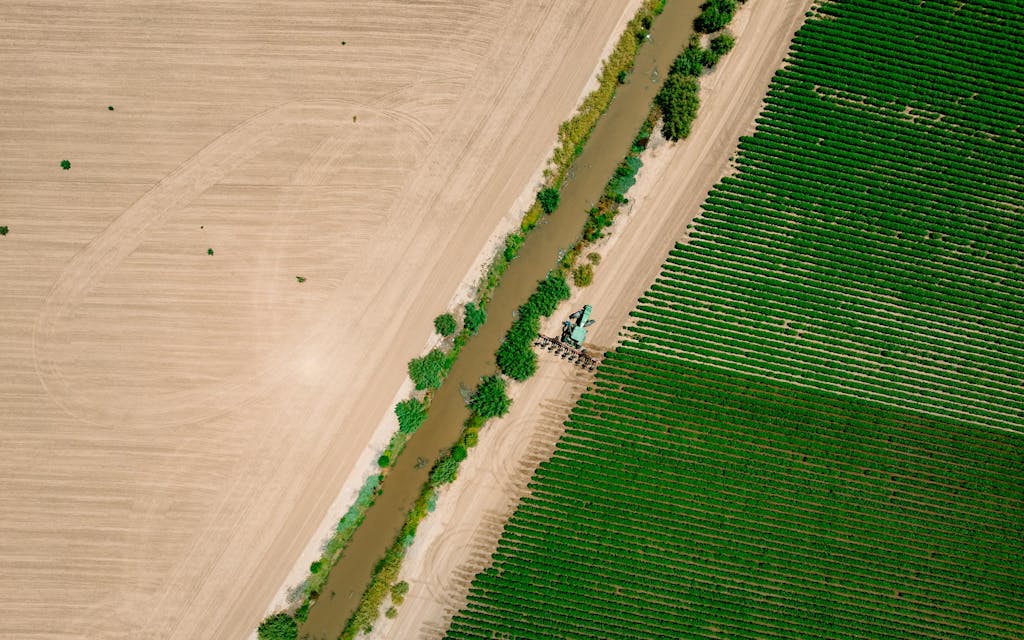
 A cotton farmer driving a tractor through cotton fields outside Fabens, Texas, on July 21, 2025.Photograph by Jordan Vonderhaar
A cotton farmer driving a tractor through cotton fields outside Fabens, Texas, on July 21, 2025.Photograph by Jordan Vonderhaar
On the other side of the state, in the farmland around El Paso, ICE hasn’t launched such large-scale raids—at least not yet. But Tirres and other farmers say the agency has made its presence felt, and workers fearing deportation—or, worse, expulsion to a prison in El Salvador or Eswatini, in Africa—have stopped coming to work. Tirres described workers living in “terror.” Even farmers who insist on hiring legal employees have to deal with increased labor costs, as increased demand for such workers drives up their pay. The scale of the loss across the country is significant. According to U.S. Bureau of Labor statistics, the agriculture industry lost a stunning 155,000 workers nationwide between March and July—the largest loss of such employees in nearly a decade.
Rollins is aware of the problem but has struggled to address it. At a hearing in June, Republican members of Congress, responding to complaints from farmers in their districts, asked urgent questions. “Recent enforcement actions have begun to impact and even target agricultural operations, and yet there’s still a lack of clarity for producers,” said Representative Glenn Thompson, a Pennsylvania Republican and chairman of the House Committee on Agriculture. He went on to ask what, if anything, Rollins was doing to ensure enforcement wasn’t impacting food security, “which I think we both agree is a matter of national security.”
Rollins stumbled through her answer, saying she’d spoken with the president earlier that morning about the danger of labor shortages on farms. She said repeatedly that Trump acknowledged the issue—but she couldn’t offer much more than that. Deportations of farmworkers would continue.
Since the 1950s, the number of Americans doing any sort of farmwork has cascaded downward, following widespread mechanization and the purchase of small farms by large conglomerates. Still, workers are required to operate those machines, and also to handle jobs such as harvesting fragile fruits and vegetables. The Trump administration argues that deportation of undocumented workers will open more jobs to Americans at higher wages—Rollins recently declared that the farm workforce will be “a hundred percent American.” But for decades, farmers like Tirres have watched native-born Americans grow increasingly uninterested in farmwork; it’s not clear there’s a wage that’s high enough to bring Americans back to the fields and keep farming profitable. In October, a Department of Labor report warned that “there is ample data showing immediate dangers to the American food supply.” The report found that in the wake of Trump’s immigration crackdown, the native-born labor market was completely failing to fill the gap. “The near total cessation of the inflow of illegal aliens combined with the lack of an available legal workforce, results in significant disruptions to production costs and threatening the stability of domestic food production and prices for U.S consumers,” it read. This means that consumers will pay significantly higher prices for food and fiber at a time when inflation is already rising. Industry experts say that if farmers and farmworkers keep leaving the industry at the current rate, this country could lose the ability to feed itself.
In the Lower Valley of El Paso Valley, Tirres surveyed a field of his cotton as water from a canal trickled slowly into the furrows. West Texas is more than two decades into one of the worst droughts to hit the region in the past five hundred years. Knowing he’d only have the water to grow cotton on a fraction of his land this year, Tirres planted a smaller crop than usual. Now, facing an even more intense worker shortage, he’s found a silver lining. “I guess you could call it a blessing in disguise that we have a shortage of water,” Tirres said. “If I was trying to farm all that I had last year, I wouldn’t have enough people.”
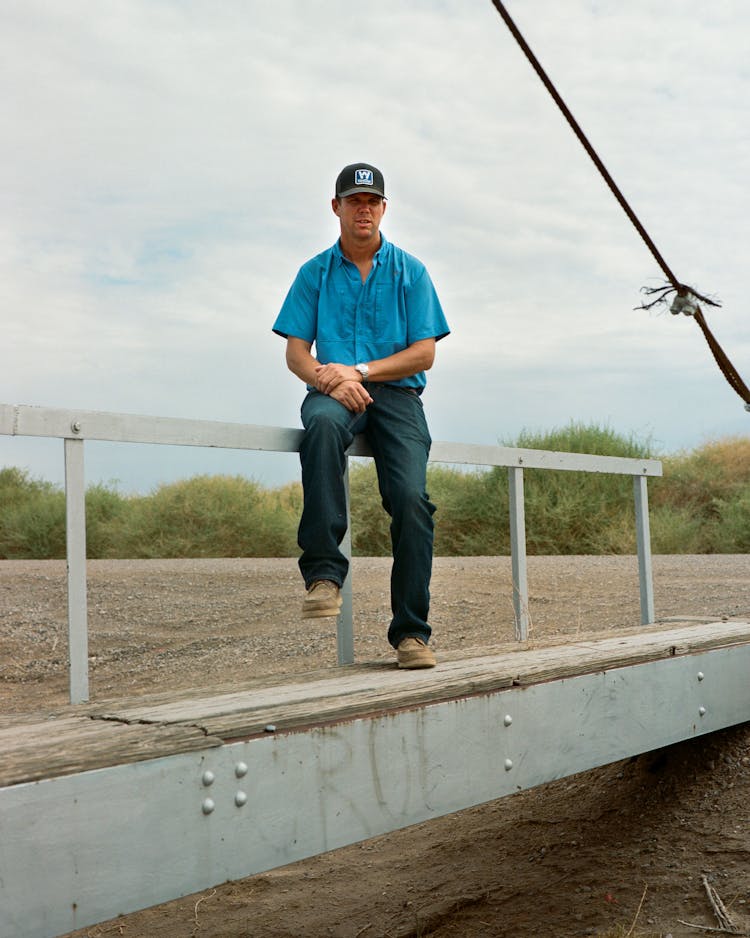 Jarett Rogers, sitting on flood irrigation near the Rio Grande, on July 21, 2025. Photograph by Jordan Vonderhaar
Jarett Rogers, sitting on flood irrigation near the Rio Grande, on July 21, 2025. Photograph by Jordan Vonderhaar 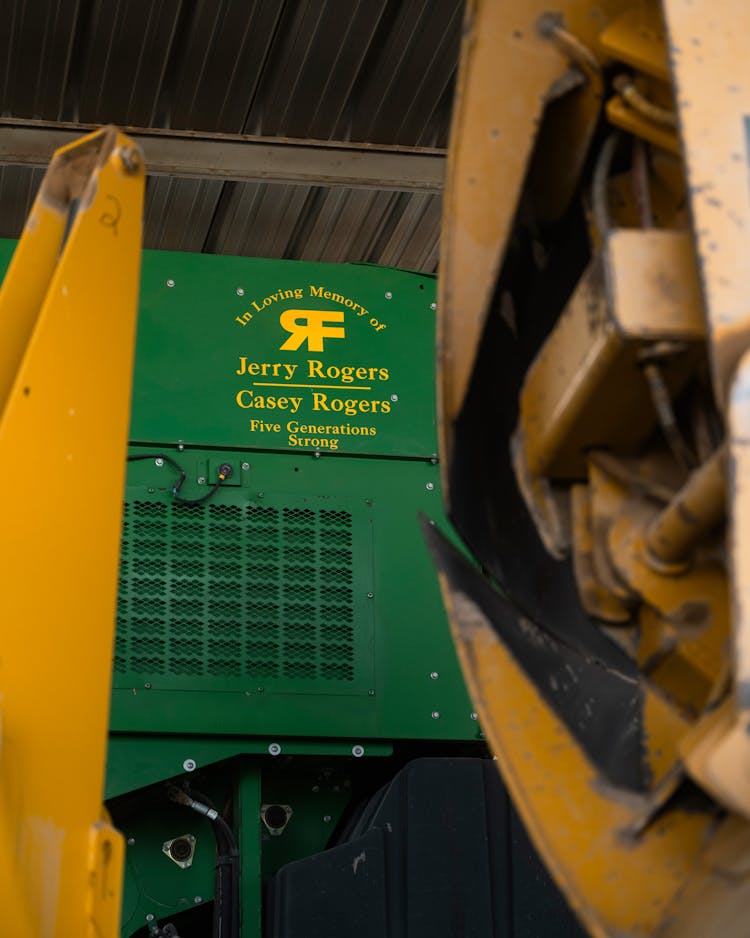 Rogers family farm equipment. Photograph by Jordan Vonderhaar
Rogers family farm equipment. Photograph by Jordan Vonderhaar
This isn’t just a story about immigration. I spoke to multiple Texas farmers this summer who referred to themselves as some version of a “dying breed” or “endangered species.” Alongside the shortage of farmworkers, the number of farmers in the country is cratering. It’s a reenforcing cycle: As worker shortages increase the cost of labor, farmers can’t keep up. In 2024 alone, the cost of labor increased 6 percent compared to the year before; the USDA expects it to increase another 4.2 percent in 2025.
In late July, a light rainfall moistened El Paso, filling the irrigation canals with a turbid, brown mix that farmers call “chocolate milk” or “arroyo water”—a nutrient-rich slurry for their plants. The unexpected rain, though, meant losing a day of work in the fields. As the sun rose on the Rogers farm in Clint, Texas, the farmhands gathered around near the tractor shed and portable office, trying to find the ways they could be most useful. Standing near his pickup, Jarett Rogers, the 37-year-old owner, took off his hat and rubbed his forehead. “We need this rain,” he said. But he was frustrated—the day before, he’d cut a field of Sudan grass and left it out to dry, getting it ready to bundle up as animal feed. Now soaking in mud, the grass was ruined. With the ground saturated, his workers couldn’t head out to the fields either. “On these wet days, you find busy work,” he said. We walked over to where a broad-shouldered man named Rudy was at work repairing a blown piston from one of the tractors. Rogers explained he only had half his crew at work today. “A couple of the older guys, they have doctors’ appointments,” Rogers said.
“Your crew is on the older side?” I asked.
“Pretty much all farmers—owners, workers, whatever—are older. Nobody wants to work nowadays. Nobody our age wants to do it,” he said. According to the latest USDA surveys, the average age of a farm laborer in the country is 39.6. Rogers’ crew is much older than that. One man named Enrique is 77 years old and has been in the country for 60 of those years. He came to the U.S. with a work visa, he said, “and he got it all the right way, the hard way.” His three kids were valedictorian or salutatorian at their high schools.
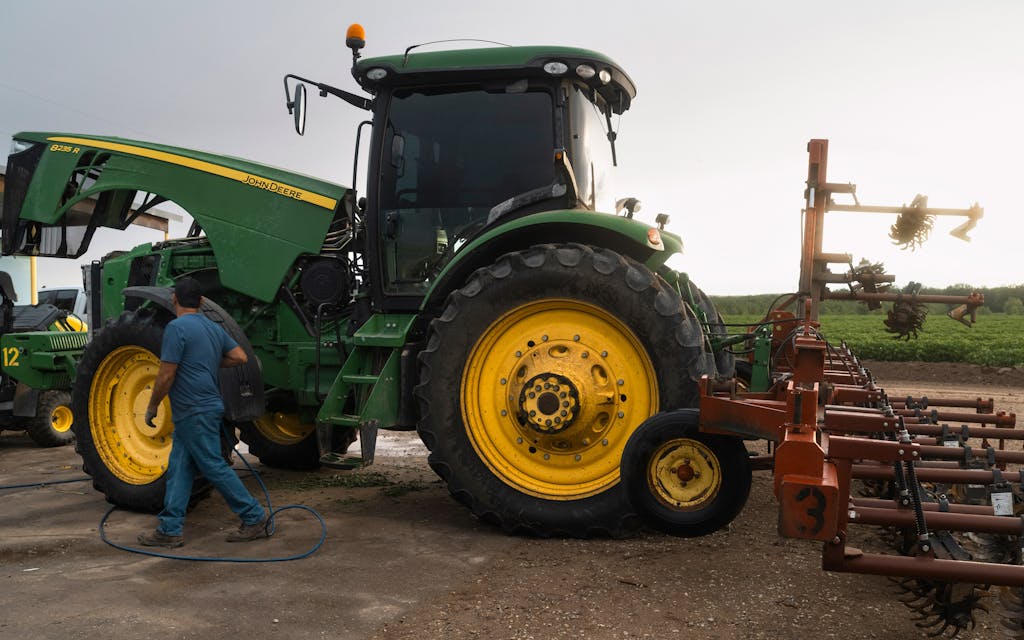
 A worker cleaning farm equipment on the Rogers farm in Fabens on July 21, 2025.Photograph by Jordan Vonderhaar
A worker cleaning farm equipment on the Rogers farm in Fabens on July 21, 2025.Photograph by Jordan Vonderhaar
Working the farm, Enrique saw three generations of Rogers take up the owner’s mantle: Jarett, his father Casey Rogers, and his grandfather, Jerry Rogers. Both of the older Rogers passed away in the last fourteen months. “It really hurt Enrique when my grandfather passed, because it was like losing a father,” Jarett told me. “And then when my dad passed, it was like losing a son.” Jarett said that he had assumed Enrique would retire. Instead, Enrique told him he wanted to spend at least one more year working; he wanted to make sure Jarett was well set up to inherit the farm.
A farmhand like Enrique is highly skilled and increasingly rare. He’s someone who can do every conceivable job on a farm and act as a foreman, trainer, and leader for other workers. Such valuable workers are tricky to hire, in part because a property like the Rogers farm is its own village. Some workers spend their whole lives living and working here. Replacing someone like Enrique is like trying to replace a family member.
After Rogers met with his workers and got the farm started, he told me he had a daily appointment to keep: breakfast with fellow farmers. We climbed into his truck and drove out of the farm toward the handful of short blocks that make up Clint’s downtown. Along the way, Rogers pointed at a small, neat house in the midst of cotton fields. “That’s the acre my grandfather gave Enrique,” he said. When we pulled up to a Mexican cafe, five gray-haired farmers were already sitting around one of the tables, and more came in after we sat down. Rogers was the only one of the group who looked younger than 60. There were sore-hip walks—and jokes about sore-hip walks—as more old-timers ambled in. This crew was representative of the profession: As of 2022, the average age of an American farmer is 58.1, a generation older than the average farm laborer. And that distribution is top heavy: There are four times as many farmers over the age of 64 than there are who are 34 or younger.
Most of the locals of Rogers’s generation—his high school classmates—didn’t stick around. Every year, thousands of children choose to sell the farms they inherit instead of working them and keeping them in the family. As the cost of labor rises—as well as the costs of fuel, equipment, and water—the already tricky profession of farming has become even more high risk and anxiety producing. Being a farmer means, almost by definition, taking on debt. There are huge, year-round operating costs (a single John Deere cotton picker can sell for north of $900,000), and you only get paid for the harvest. High interest rates make borrowing more expensive, and today many farmers are struggling to stay ahead of their debts. Stress is endemic to the profession; rates of alcoholism among farmers is high. Young people in farm country see their parents struggle, and they decide it’s not worth it. When they leave town and have children of their own, it creates a cycle that only hastens the decline of American farming: With fewer young people growing up around farmers, fewer of them consider going into farming.
In the years since Rogers’ grandfather Jerry was born, America has lost the majority of its farms. In 1935, there were more than 6.8 million; today, for the first time since the nineteenth century, there are fewer than 2 million. Most of these properties have been lost to consolidation, as family plots get swallowed by larger and larger industrial operations. But, since the fifties, the total acreage under cultivation has also declined, as reflected in the Department of Agriculture’s five-year censuses. Texas has been amongst the hardest-hit states: Between 2017 and 2022, the total area of farmland in the state decreased by around 1.6 million acres.
Jarett is aware his three kids might want something else from life when they come of age. He said he’d understand if they choose to sell the farm and move on. “I don’t want to put a burden on them if farming is not going good,” he said. As we drove through his pecan orchards, he told me that he keeps his legal and financial affairs in tight order, and he has one of the farmers we met at breakfast written into his will, so that man can take over farm operations if Rogers dies unexpectedly. Still, he’s hopeful his kids will stay in love with farm life. The girls are already riding horses, and Jarett’s wife Ana-Florencia Rogers has them working on a bountiful hobby farm and produce stand she’s cultivated on the roadside north of their house. I watched both parents break into broad grins as their eldest daughter, running around in her cowboy boots, held up one of the potatoes they had harvested this summer.
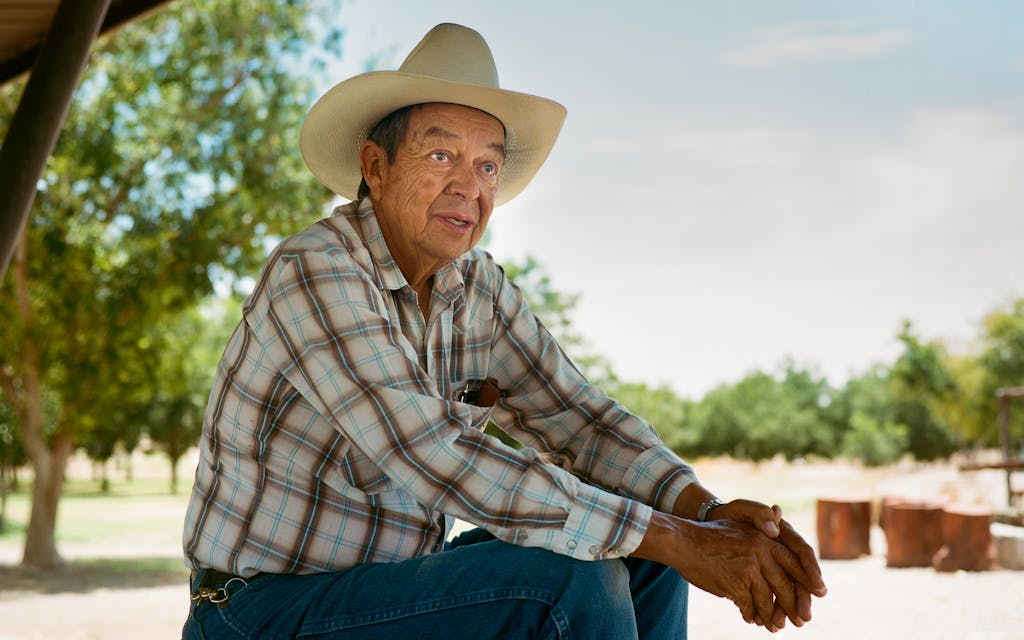
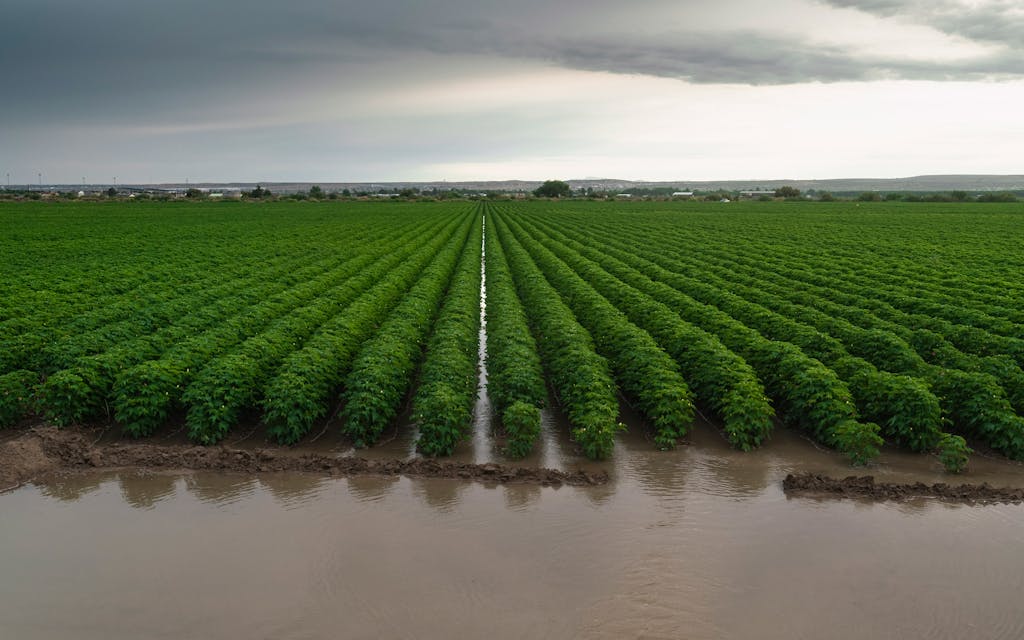 Cotton fields irrigated via flood irrigation with water from the Rio Grande on the Rogers farm.Photograph by Jordan Vonderhaar
Cotton fields irrigated via flood irrigation with water from the Rio Grande on the Rogers farm.Photograph by Jordan Vonderhaar
Tirres seeded his first field of cotton in 1975 near Clint, in the Lower Valley of El Paso.
In those days, he never struggled to find labor. “I used to always have a list of people that I could call whenever I needed any kind of workers,” he said. Locals competed over farm jobs. But for at least fifteen years, Tirres said he’s noticed that the younger generation “doesn’t want to work on farms.” “My crew has been with me for quite a few years, but some are older than I am, and in the last three years, I’ve had three retire,” he said. “I haven’t been able to find replacements.”
Over the years, as fewer and fewer locals sought work as farm laborers, Tirres and other employers in the Valley have turned to what Tirres called “outside labor”: Mexican immigrants. Historically, many workers across the El Paso Valley lived in the villages on the other side of the Rio Grande and came north to work. They’d labor during the growing season, complete the harvest, then cross back over the river for the offseason. Tirres pointed at an arroyo, a dry gully, that ran through his fields, and explained that he used to frequently meet migrants moving north through there. They were uniformly polite. “We used to give them food—my own men would fork over their lunches to give it to them, and they’d just keep on going,” Tirres said. Some farmers in the area hired the migrants to pull weeds or work odd jobs. At various points in the last two decades, more than half of the country’s farm laborers have been undocumented.
When I asked Tirres when he first began noticing the number of workers looking for jobs go down, he had an easy answer. “Drastically? When they started building the fence.” In 2006, President George W. Bush’s Secure Fence Act passed, and border walls started going up in El Paso. Today, the barrier stretches for some eighty miles south of El Paso, deep into farm country. The wall, and a massive surge in Border Patrol agents, interrupted the flow of informal seasonal workers, and this tightened the competition to hire workers who have legal status. (Some researchers argue that, ironically, increased enforcement on the border is a major reason the undocumented population in the States grew so significantly from the ’90s to the 2010s—instead of crossing back and forth, the seasonal workers just stayed put in the States.)

 Ramon Tirres on his cotton farm in Fabens on July 21, 2025.Photograph by Jordan Vonderhaar
Ramon Tirres on his cotton farm in Fabens on July 21, 2025.Photograph by Jordan Vonderhaar
Texas farmers tend to be politically conservative but decidedly flexible on the issue of immigration. This is rural Texas: Hard work and doing things the honest way are lionized, and line cutting is universally abhorred. However, farmers know that without immigrant labor—and, more to the point, without undocumented labor—their industry would collapse. All the farmers I met spoke bitterly about the political divide. They didn’t express much confidence in either party to fix the immigration issue or their labor crisis. “These two sides, all these years, they just cannot come together on a specific immigration policy, not something decent,” Tirres said. “Everybody’s always pushing one against the other all the time.” Rogers had a characteristically colorful way of putting it: “You know, we’re over here like, ‘Hey, let’s help these illegals become citizens, become taxpayers, become a better part of society’—and then people are like ‘How dare you call them illegals!’”
Today there’s only one real program for farmers to import legal foreign labor: the H-2A visa program for seasonal workers. (The famous—or perhaps infamous—Bracero program ended in the sixties). The number of H-2A visas has increased nearly threefold in the last decade, to more than 310,000 per year.
“But gosh, that program—you just about have to adopt them to have them here,” Tirres said. Would-be immigrants can’t apply for the program; U.S. farmers have to initiate the visa process as sponsors. Tirres works on the board of the local cooperative cotton gin that all the major farmers use, and he said that, unable to find American workers, the gin had hired a few new employees through H-2A. It was difficult. The program places more than 200 rules on the recruiting process. For instance, farmers have to provide proof they contacted past employees about job openings before they even begin the H2A process. (The process used to be even more Byzantine—in the original iteration of the program, farmers were required to advertise job openings in print newspapers in Mexico and other countries; they were not permitted to post openings online-only until 2019.). In Congress, Republicans with farmers in their districts are well aware of the need to improve the H-2A program. In 2024, a bipartisan working group on the House Committee on Agriculture put out a list of policy recommendations that Republicans and Democrats in the group had unanimously agreed on to streamline H-2A visa applications. Since then, Congress has not passed any legislation addressing those recommendations. This summer, Texas Congresswoman Monica De La Cruz introduced a bill aimed at lowering the minimum pay requirements for H-2A workers—a move farmers applauded but that farmworkers say will only increase exploitation, which in turn discourages new workers from entering the field.
Immigration reform is the first and easiest answer toward alleviating the farm workforce crisis, but even that isn’t a silver bullet. Even in Mexico, farmers are struggling to find workers. Three-quarters of Mexican farmworkers over the age of 45, making the typical campesino south of the border even older than the average farm laborer in the States. Mexico’s farm-labor shortage has gotten so severe that the largest producers are lobbying the Mexican government to create its own guest-worker program, so Mexican farmers can hire more Central American farmworkers. This is a global trend, and it will define the next century: Worldwide, the number of people willing to work the fields is plummeting, as populations get richer and more urban.
At a press conference in July, Rollins, Trump’s agriculture secretary, began to give somewhat clearer answers to the administration’s thinking when it comes to farm labor: “Mass deportations continue, but in a strategic and intentional way as we move our workforce toward more automation and toward a hundred percent American workforce,” she said.
As I drove away from Tirres’s fields, I watched a massive tractor drive itself nimbly through a cotton field, churning the earth to prevent weeds from growing. It’s hard to imagine a crop whose cultivation is more automated than cotton. Unmanned tractors create furrows, plant seeds, and harvest bolls. Enormous, robotic gins strip the cotton from stems and separate the seeds. But someone still has to program those machines, perform maintenance, and drive them on county roads. You need a human being to tell when an irrigation canal is overflowing and a team of humans to fix it. That’s why every cotton farmer I spoke with in West Texas said they’re still struggling to find workers—and, if it keeps getting harder, farming cotton in the state could become impossible.
Read Next

